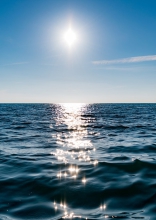
About two decades ago, people in economic circles started looking into how to integrate natural resources into conventional economic indicators, in order to better take into account the general well-being of society and the state of the environment. This environmental economic accounting principle led to what we understand today as 'natural capital accounting', i.e. assigning a monetary value to certain ecosystem services or natural resources. Initially, this mainly focused on terrestrial ecosystems. But given the great social importance of the ocean – for instance in the fight against global warming – the marine domain has started to catch up.
The challenges of marine carbon accounting
In the context of marine climate mitigation, it is important to properly monitor processes leading to the uptake and permanent fixation of carbon dioxide – the so-called ‘carbon sequestration’ - and to quantify them as accurately as possible. Only then these processes can formally be recognised as a valid contribution to climate or environmental goals, and included in the national carbon budget. Quite a challenge! In this regard, developing transparent, science-based and universal marine carbon accounting guidelines are crucial.
Early in this exercise, the economic validation of marine carbon uptake and storage focused mainly on 'blue carbon' ecosystems (salt marshes, seagrasses, mangroves). Their carbon credits are already being traded on the voluntary (unregulated) carbon market. However, the continental shelf – the seabed less than 200 m deep – also contains large amounts of organic carbon in the sediments that could potentially play a very important role in climate regulation. However, the amount and distribution of this sedimentary carbon has not yet been sufficiently mapped. Also, little is known about how the stability, accumulation rate and passage of organic carbon through the system and how these processes are influenced by natural and anthropogenic changes.
Belgian North Sea assets as a test lab
Our North Sea is a well-studied, yet intensively used (disturbed) shallow sea. In other words, the region is the perfect location to conduct research – through various pilot projects – into the marine carbon cycle, and on how the process of marine carbon sequestration can be monetarily validated. Such an achievement would greatly benefit the universal concept of marine carbon accounting and have major implications for area-specific climate mitigation strategies, marine spatial planning and the sustainable growth of the Blue Economy.
An important asset here is that in the North Sea region we can draw on the expertise and infrastructure of the ICOS Oceans Network consisting of 23 marine observatories in eight countries. The network provides high-quality, independent and transparent long-term data of CO2 concentrations at the sea surface and in the atmosphere above it. In Belgium, the ICOS Oceans Network uses the research infrastructure of the Flanders Marine Institute to carry out certified observations. The partnership between VLIZ and ICOS Oceans can be seen as a crucial tandem on which local policymakers can rely to monitor climate impacts for the region and guide sustainable developments in this economically important and naturally valuable area.
Reference
The opportunities and challenges of marine carbon accounting - a case study for the North Sea shelf ecosystem and the potential value of the ICOS Oceans Network. Dauwe et al. (2023) | VLIZ-bib
Download the PDF of the policy informing brief through this link: www.vliz.be/imisdocs/publications/386005.pdf
Image: freegreatpictures.com